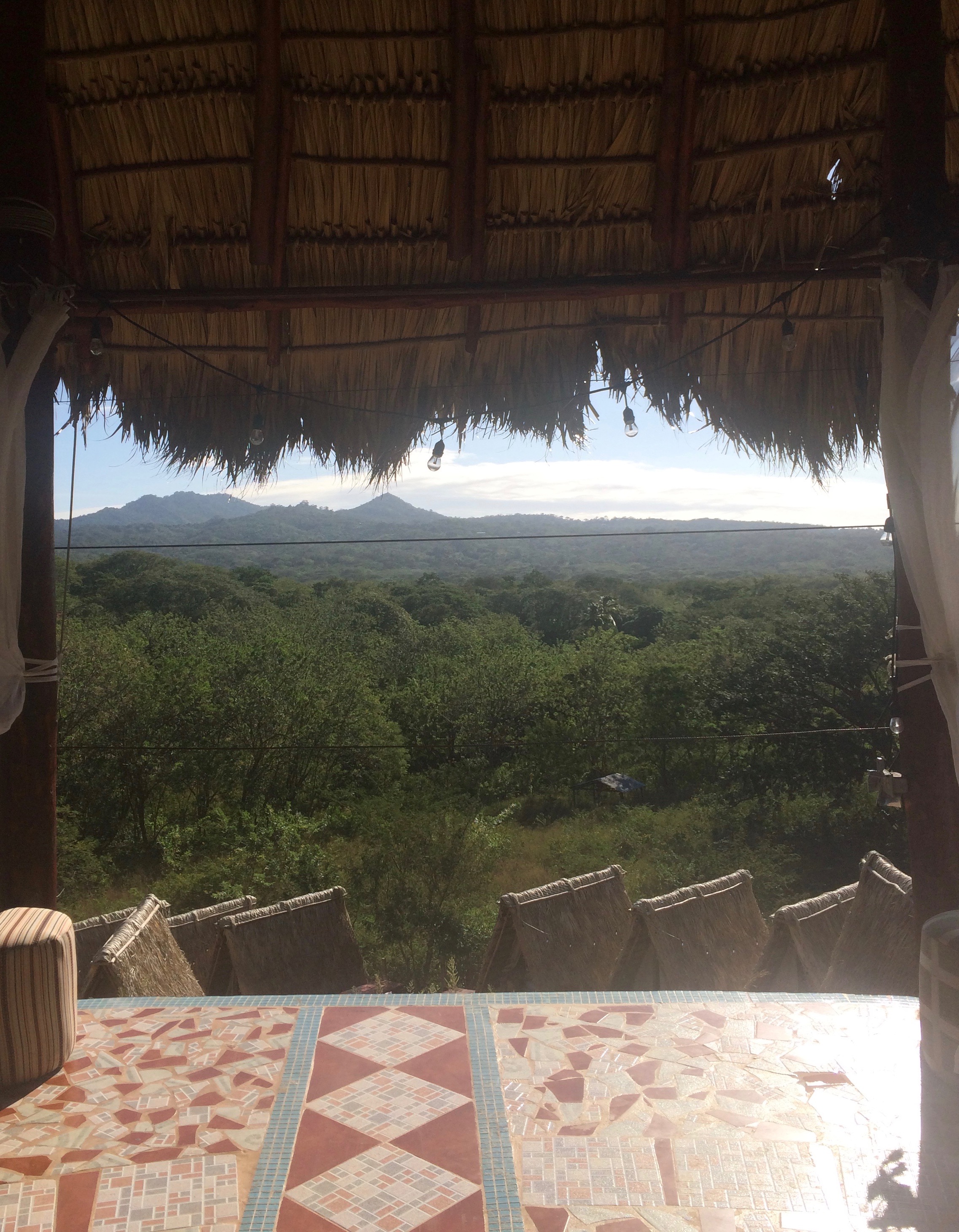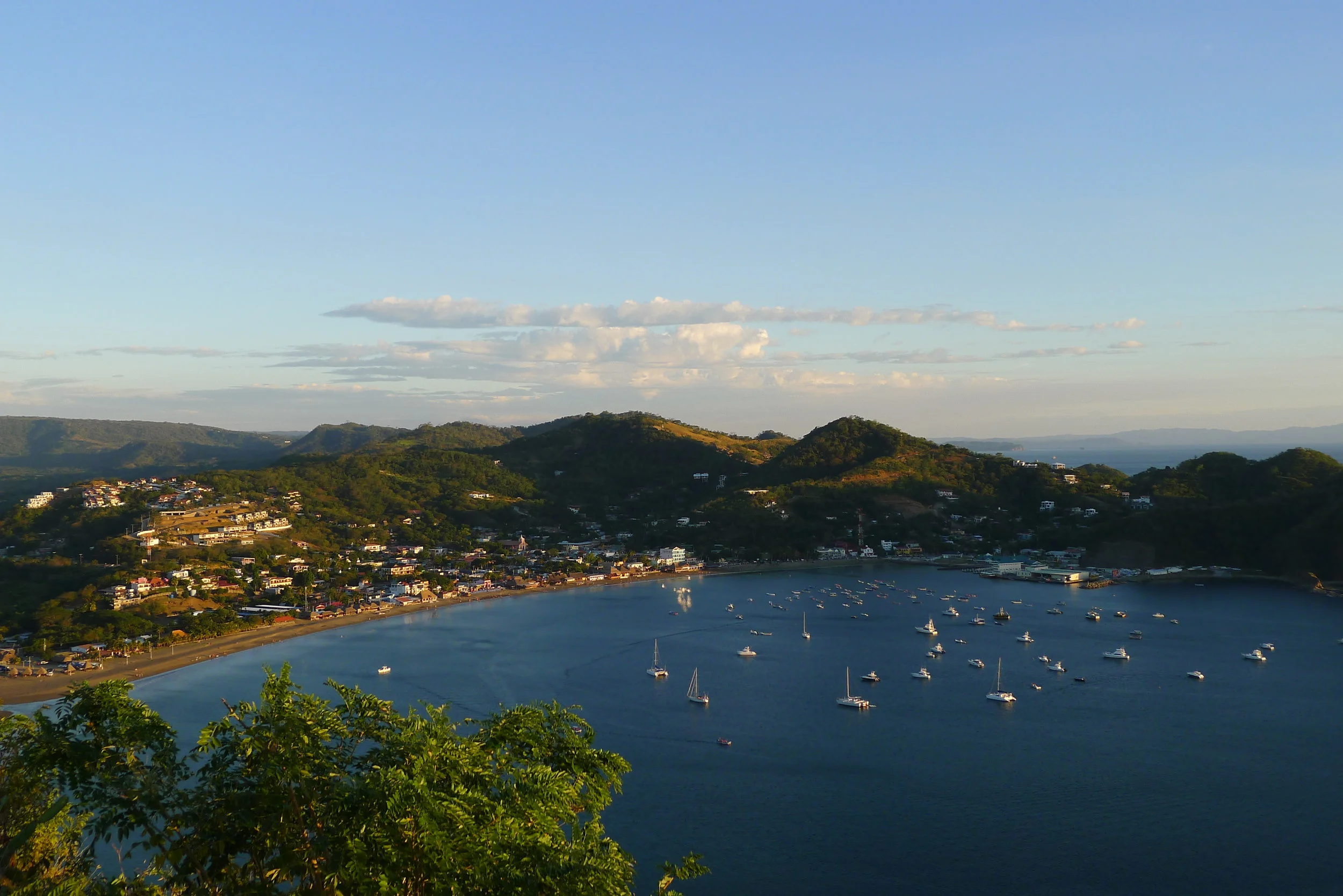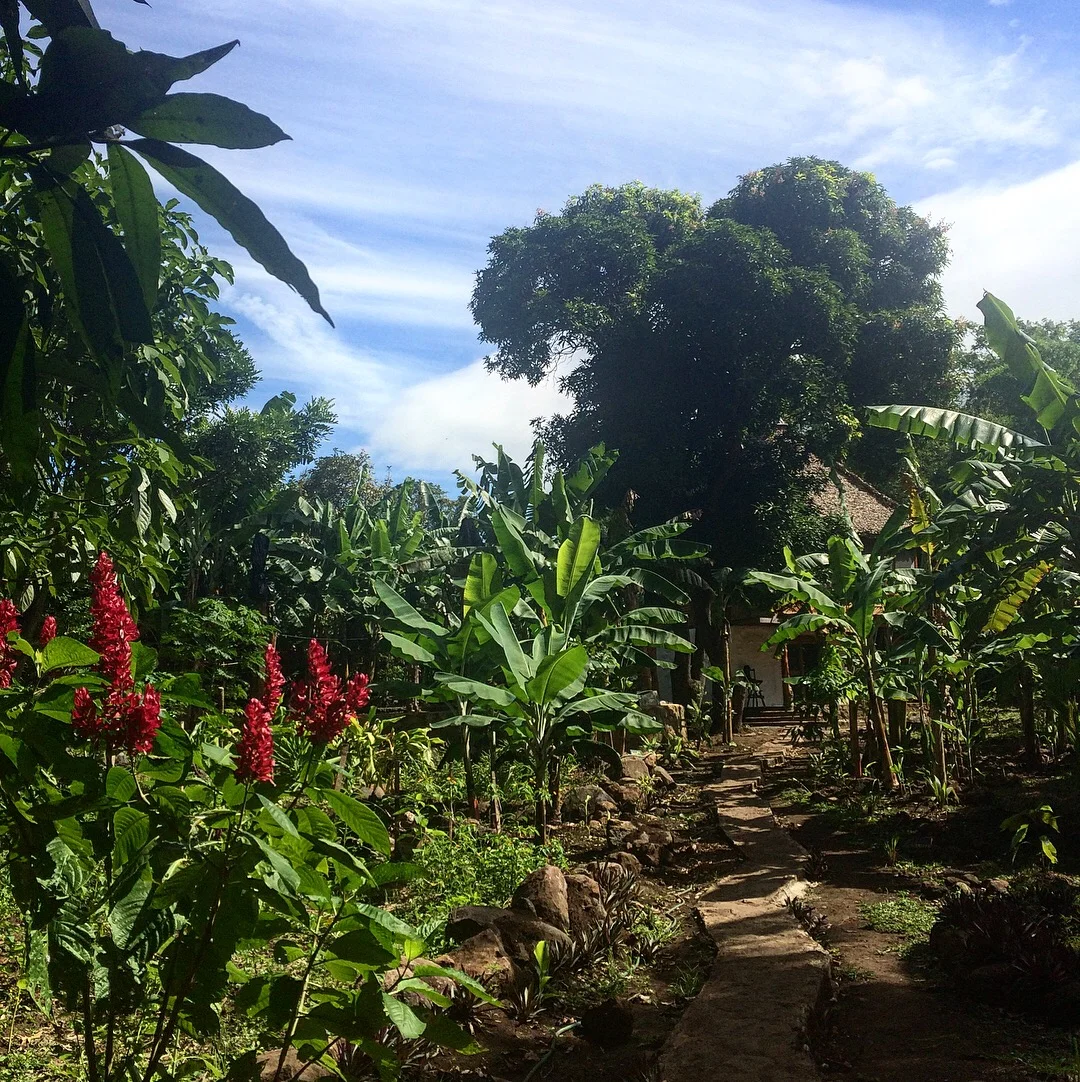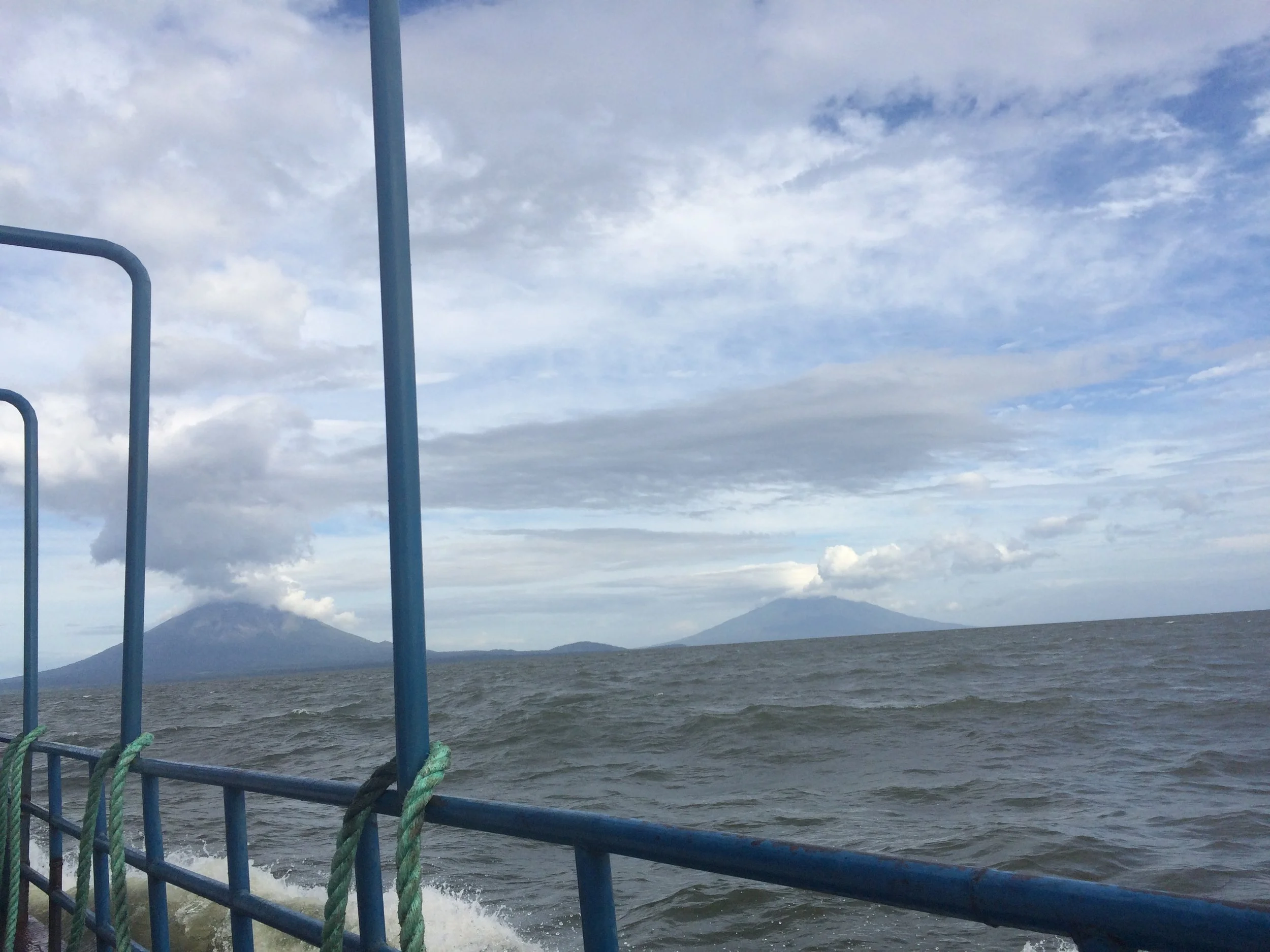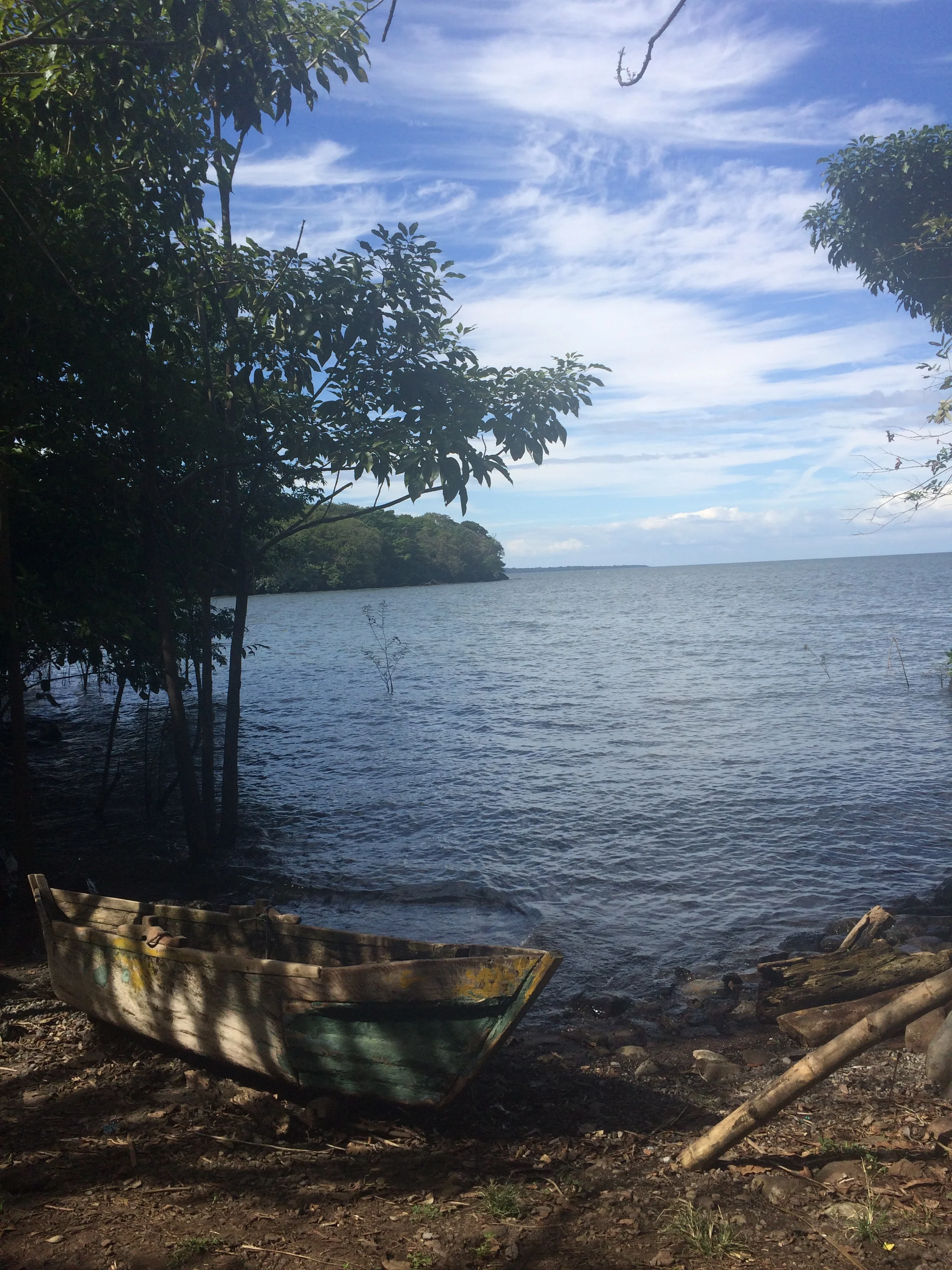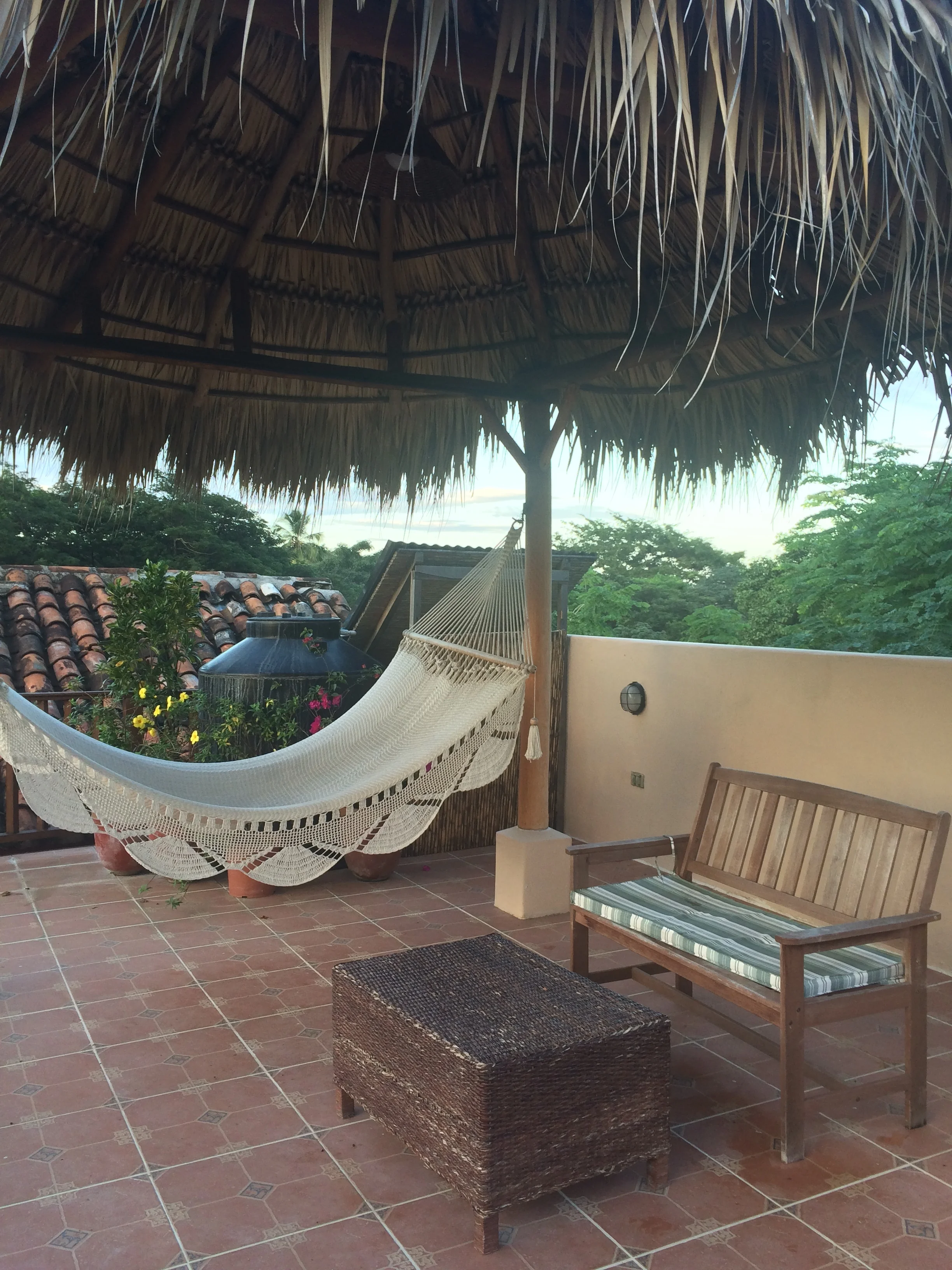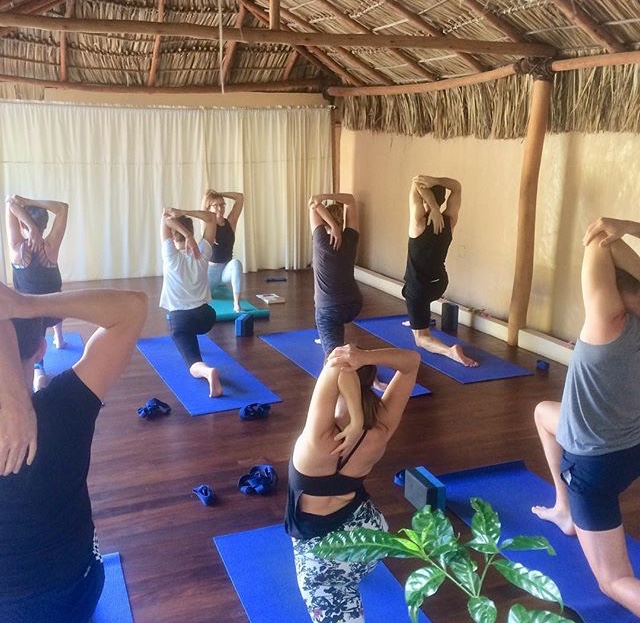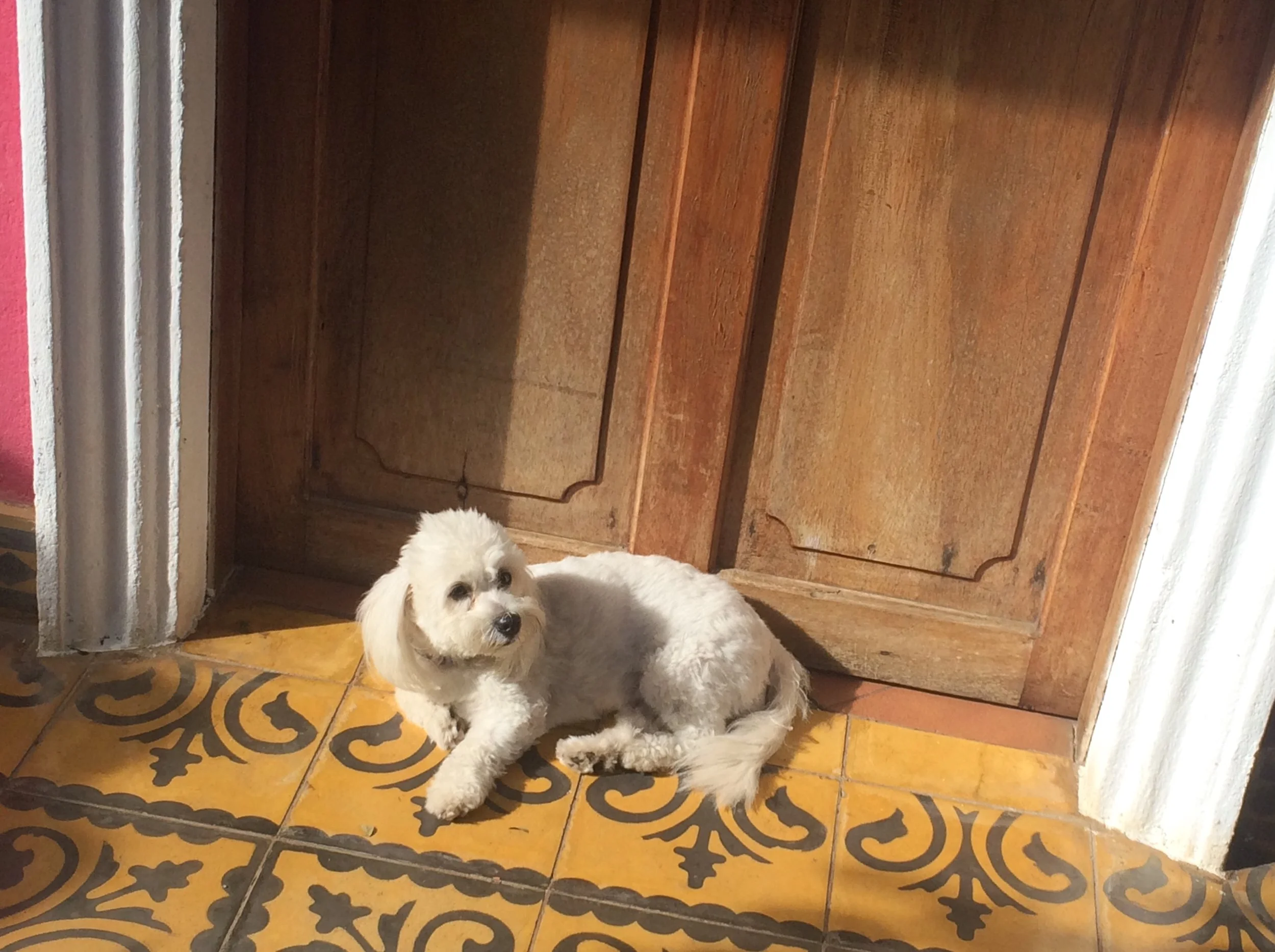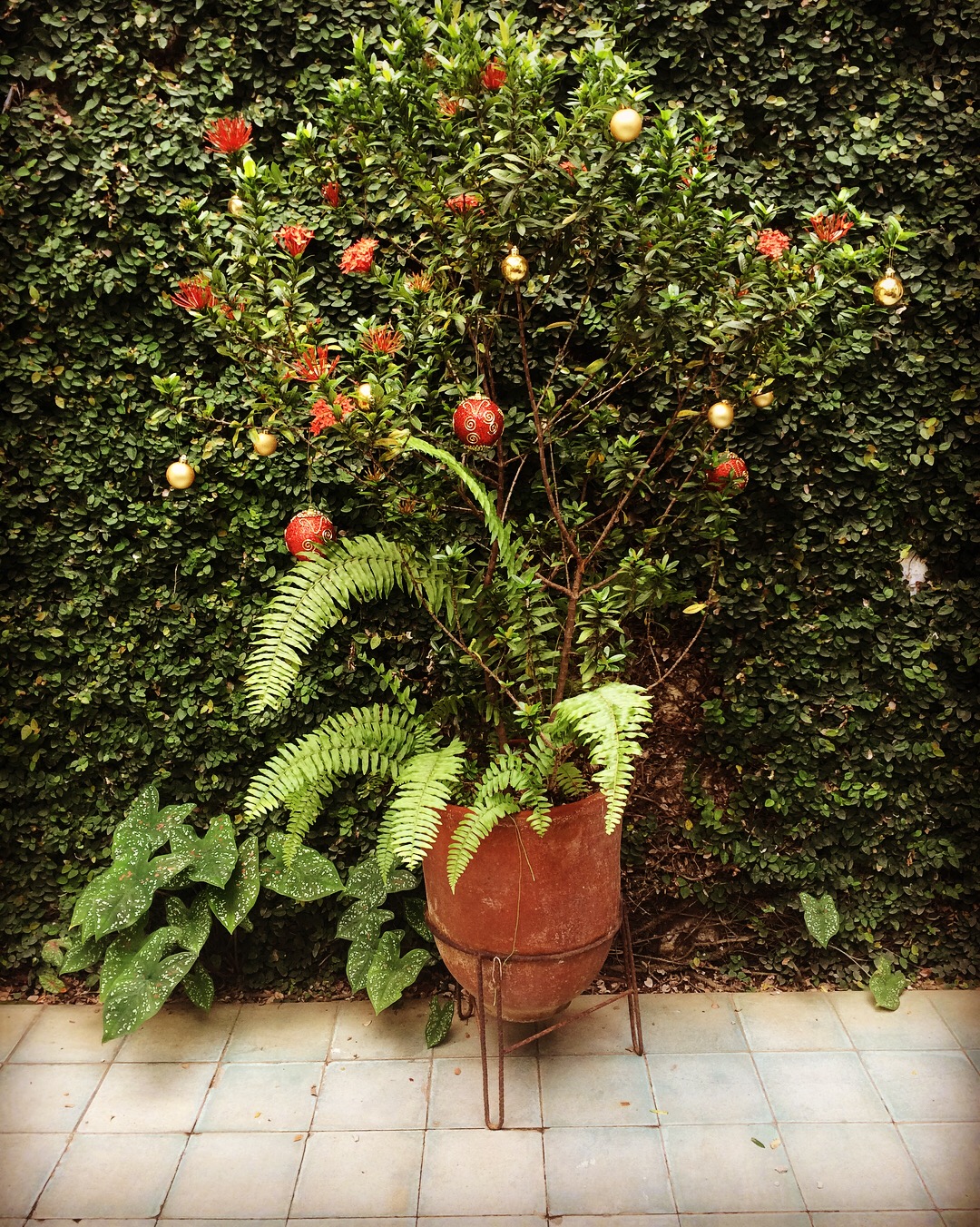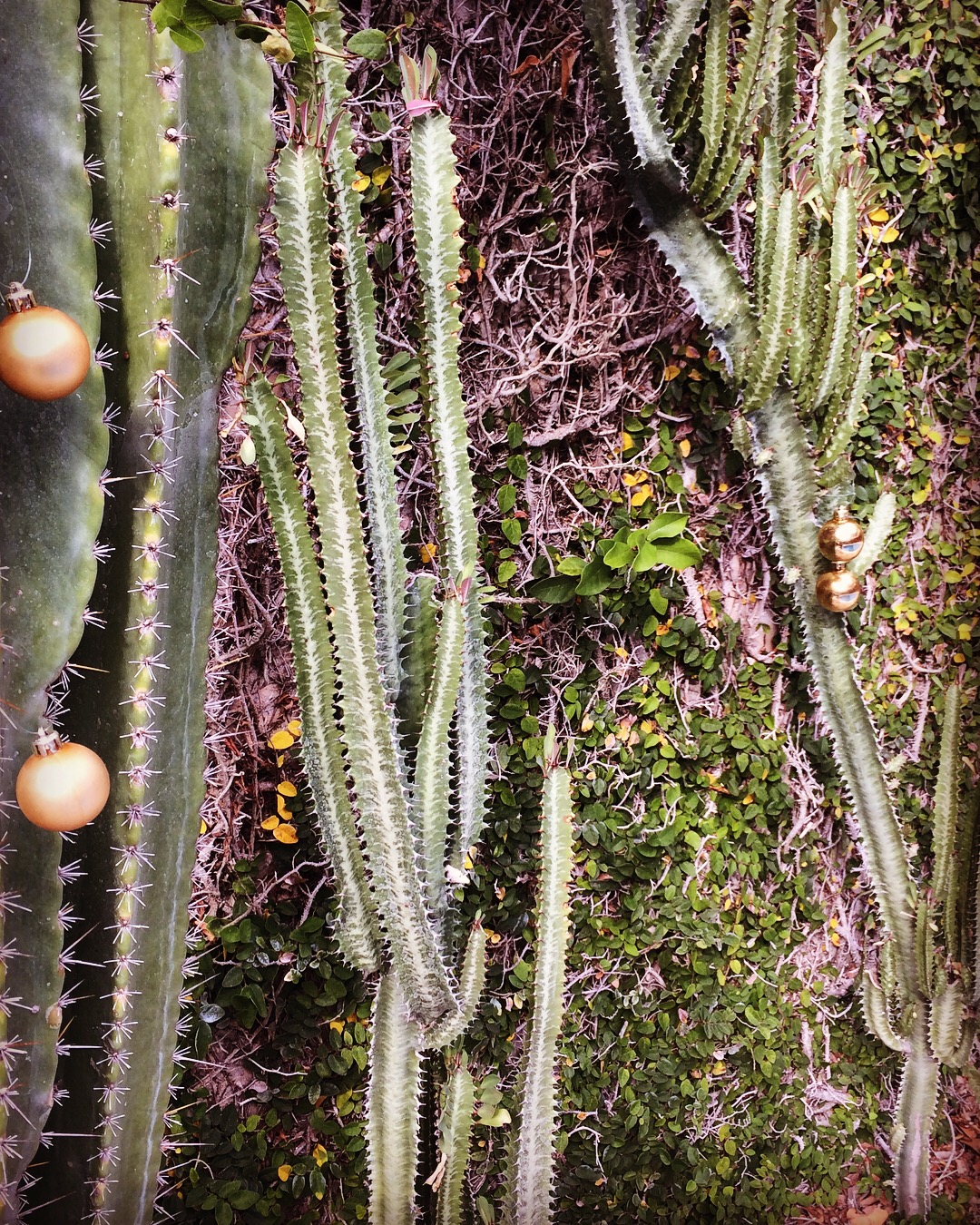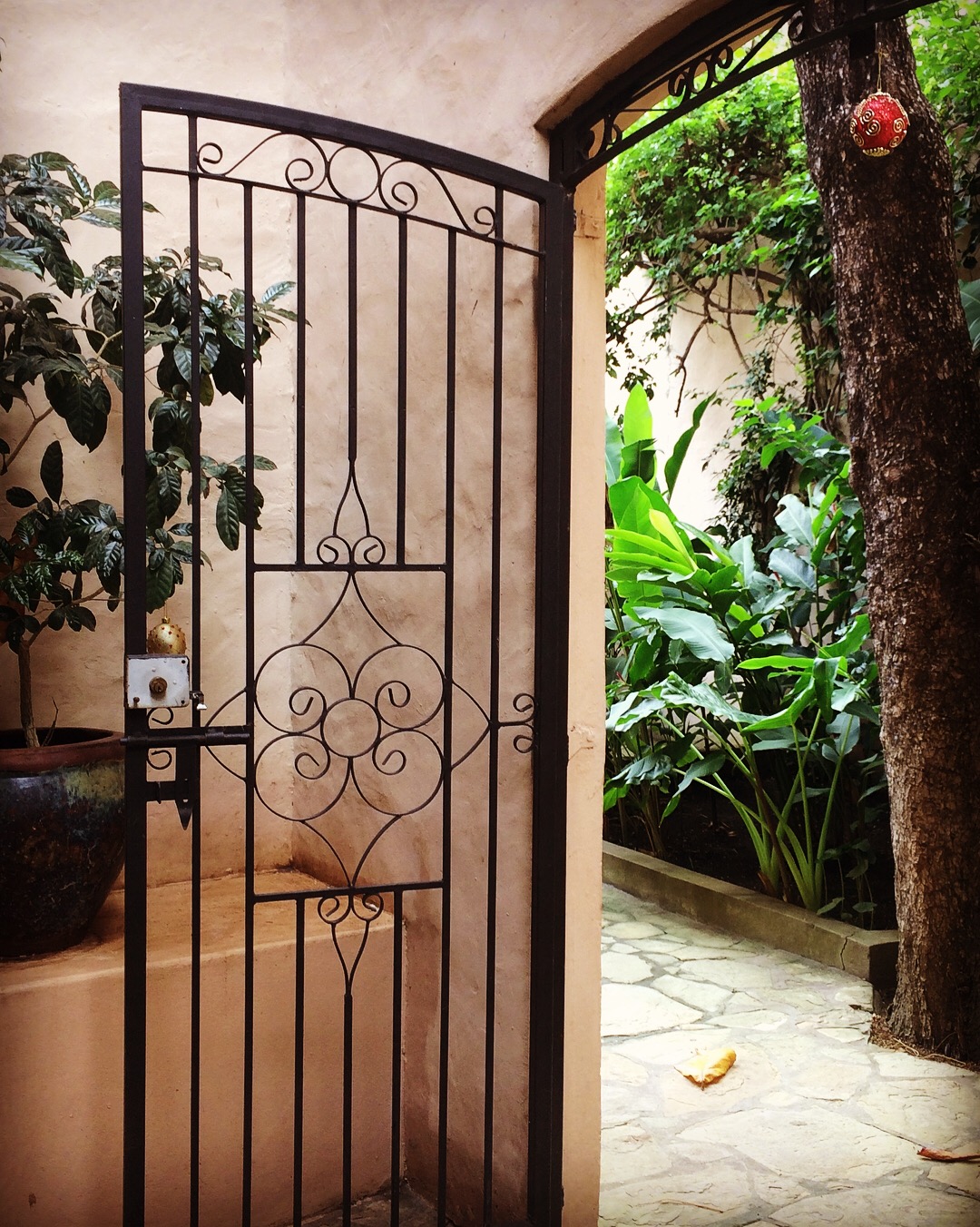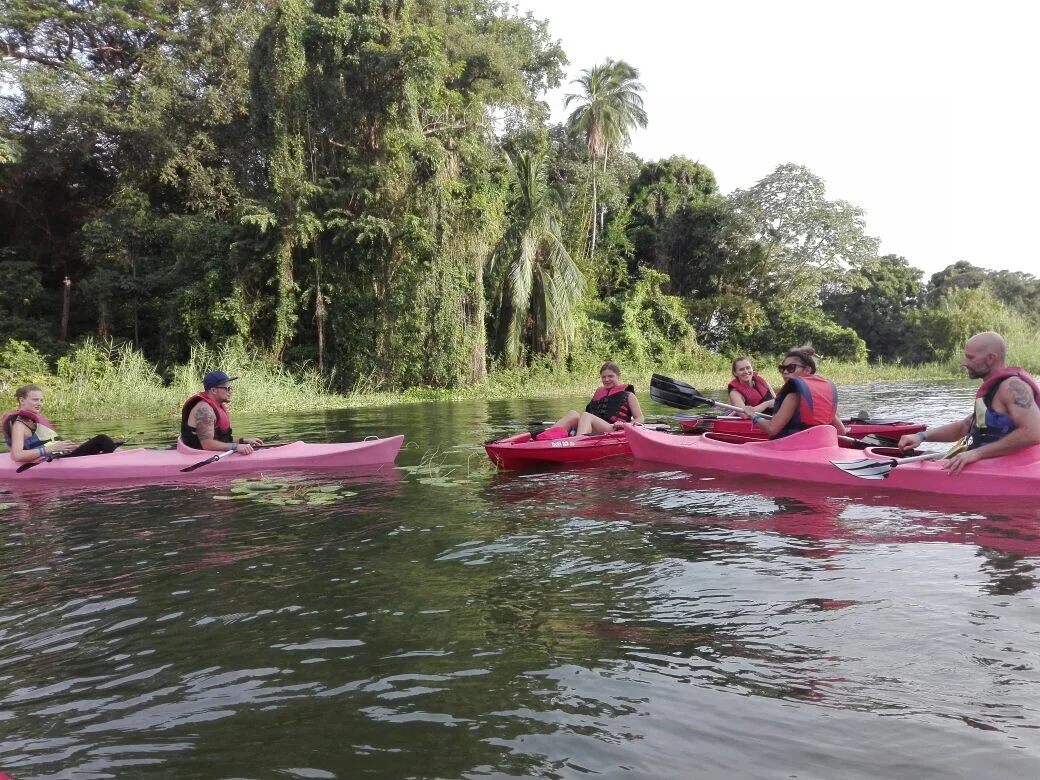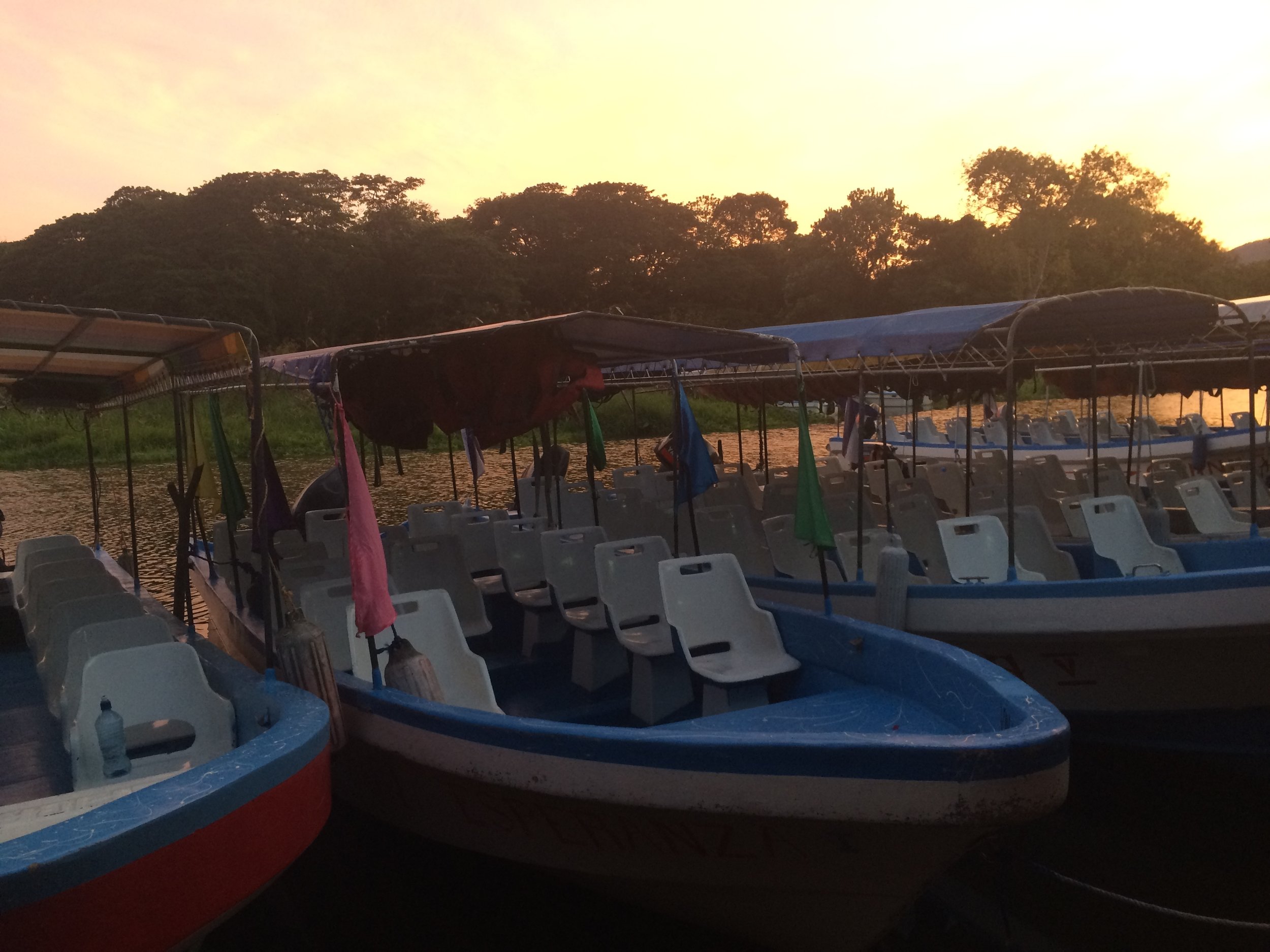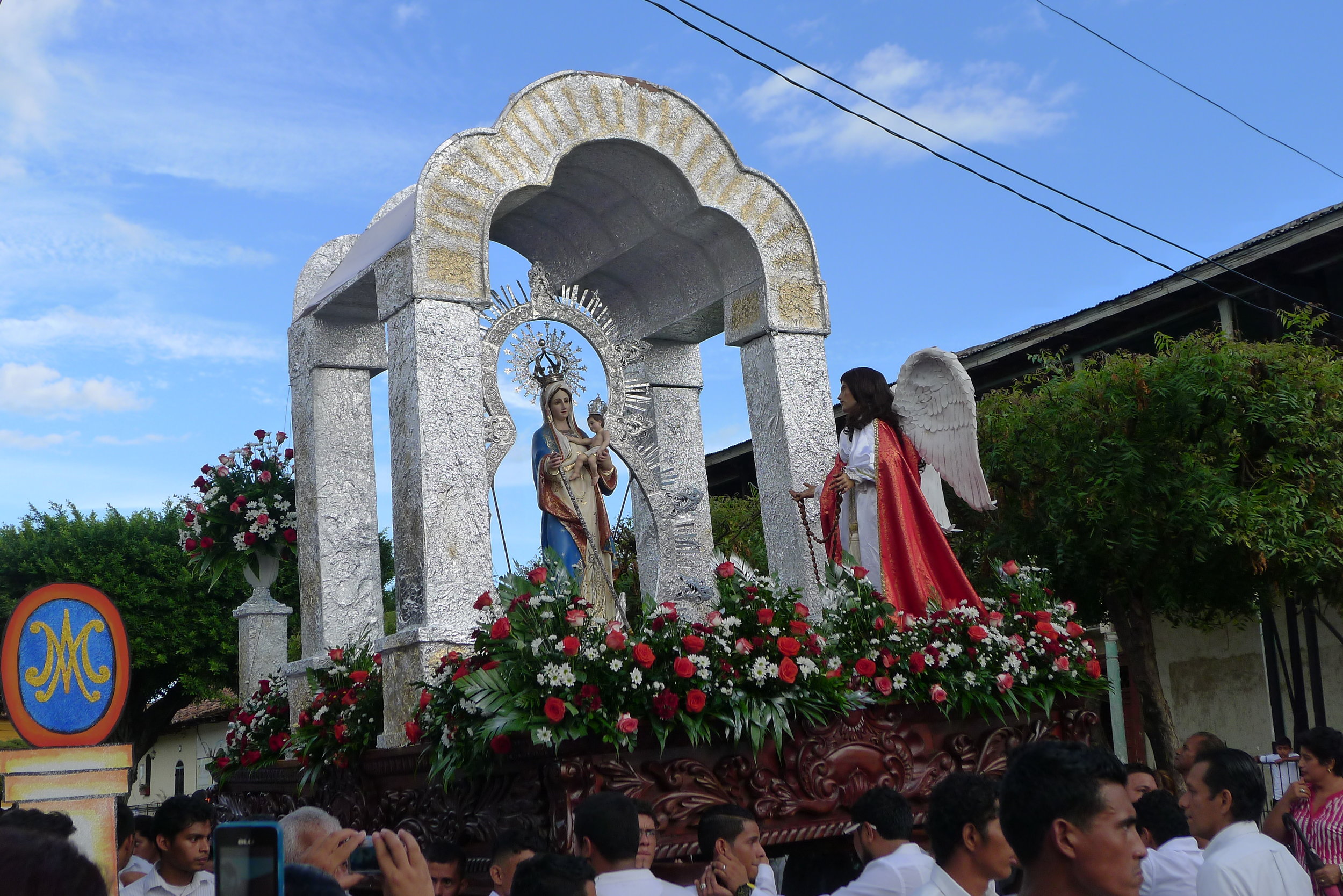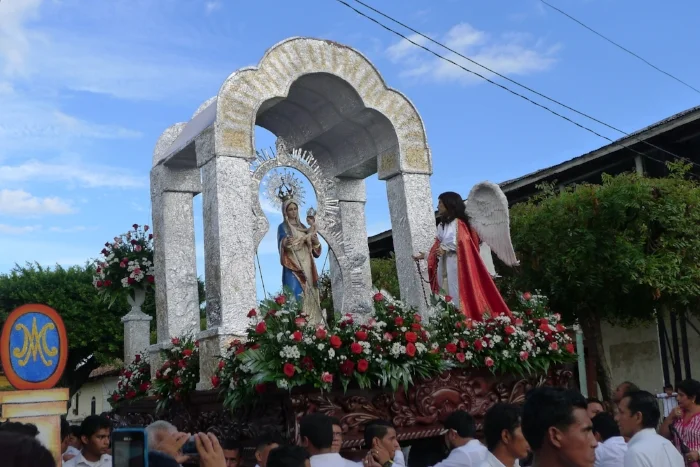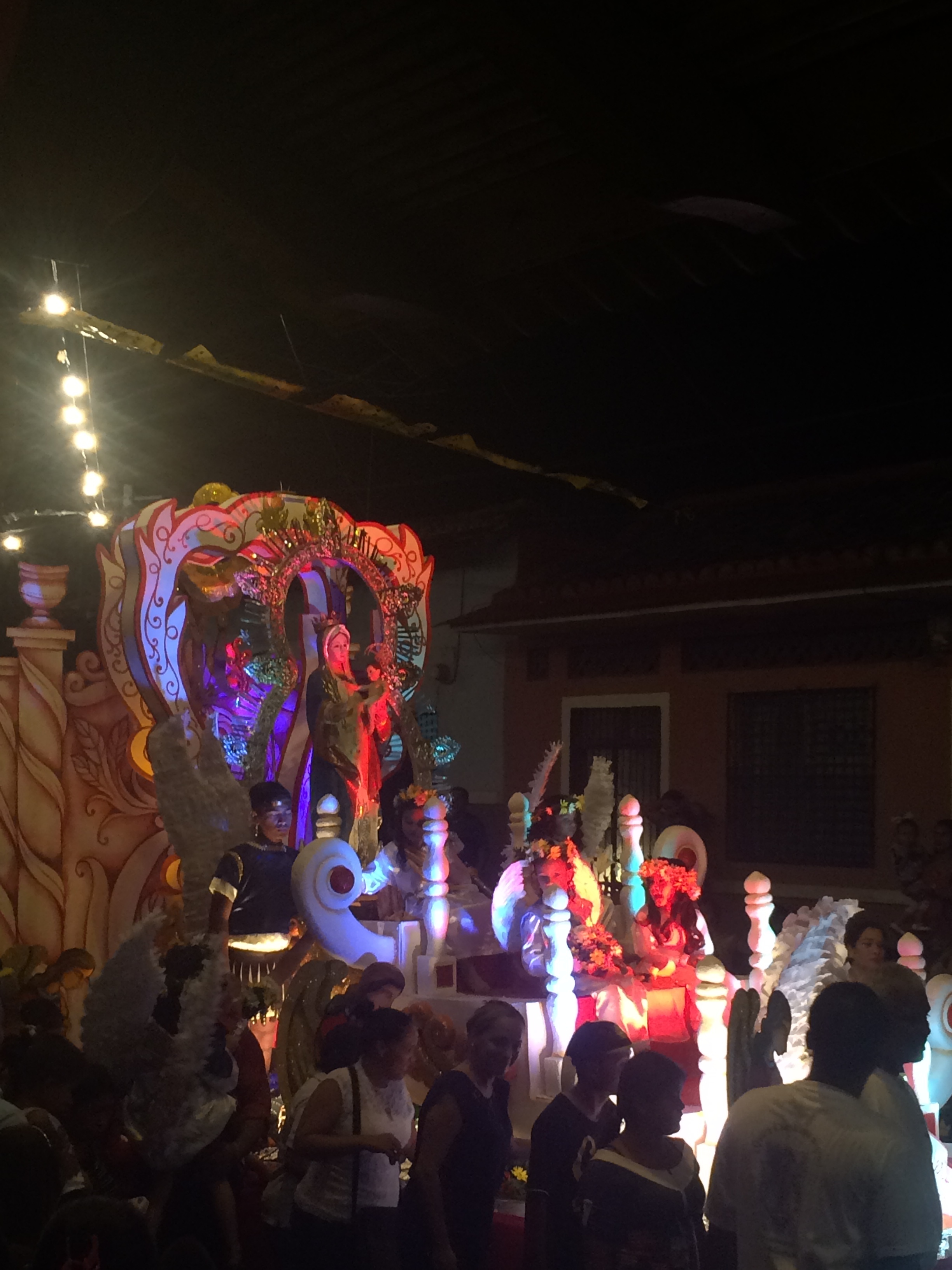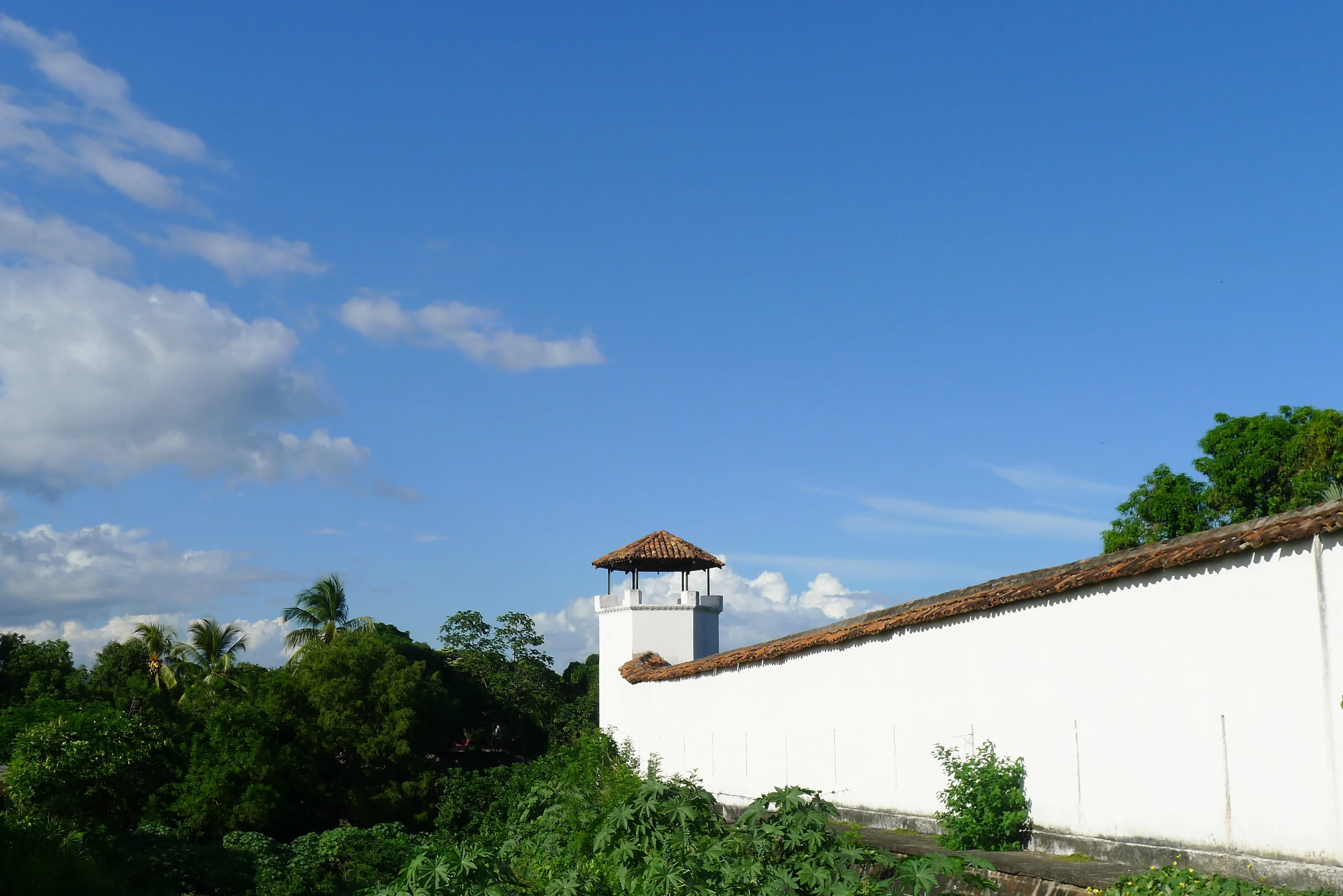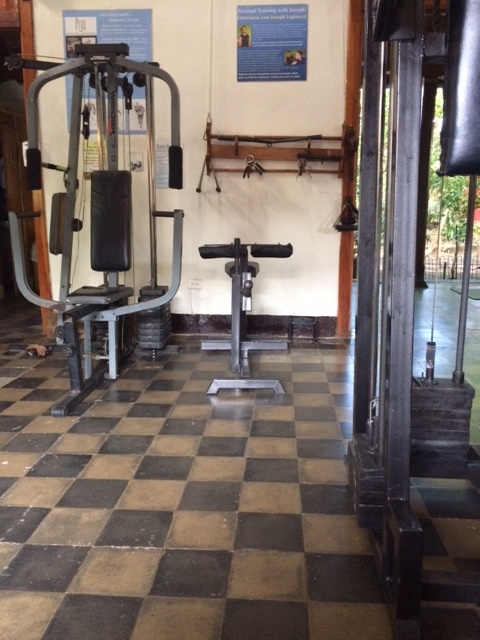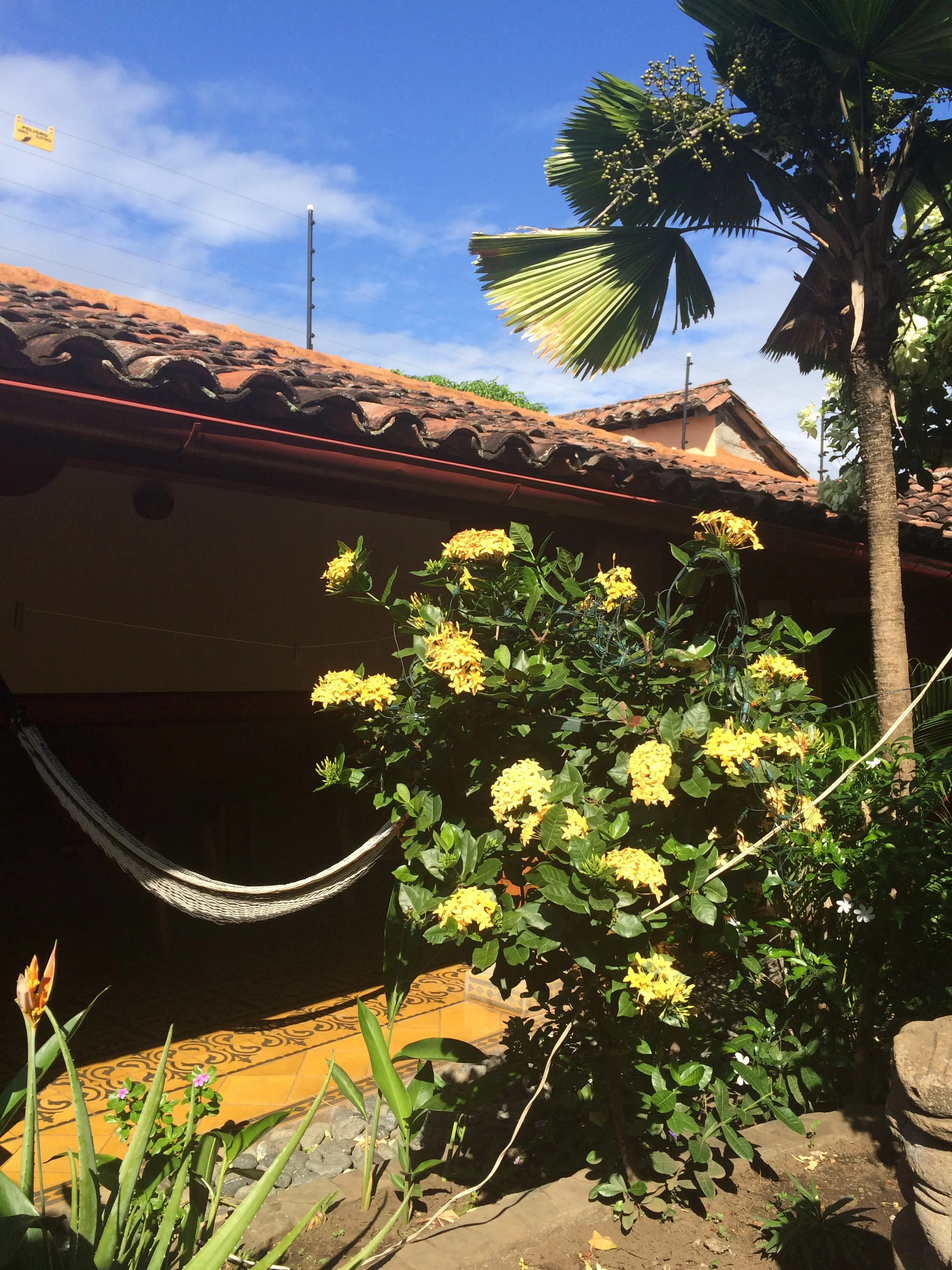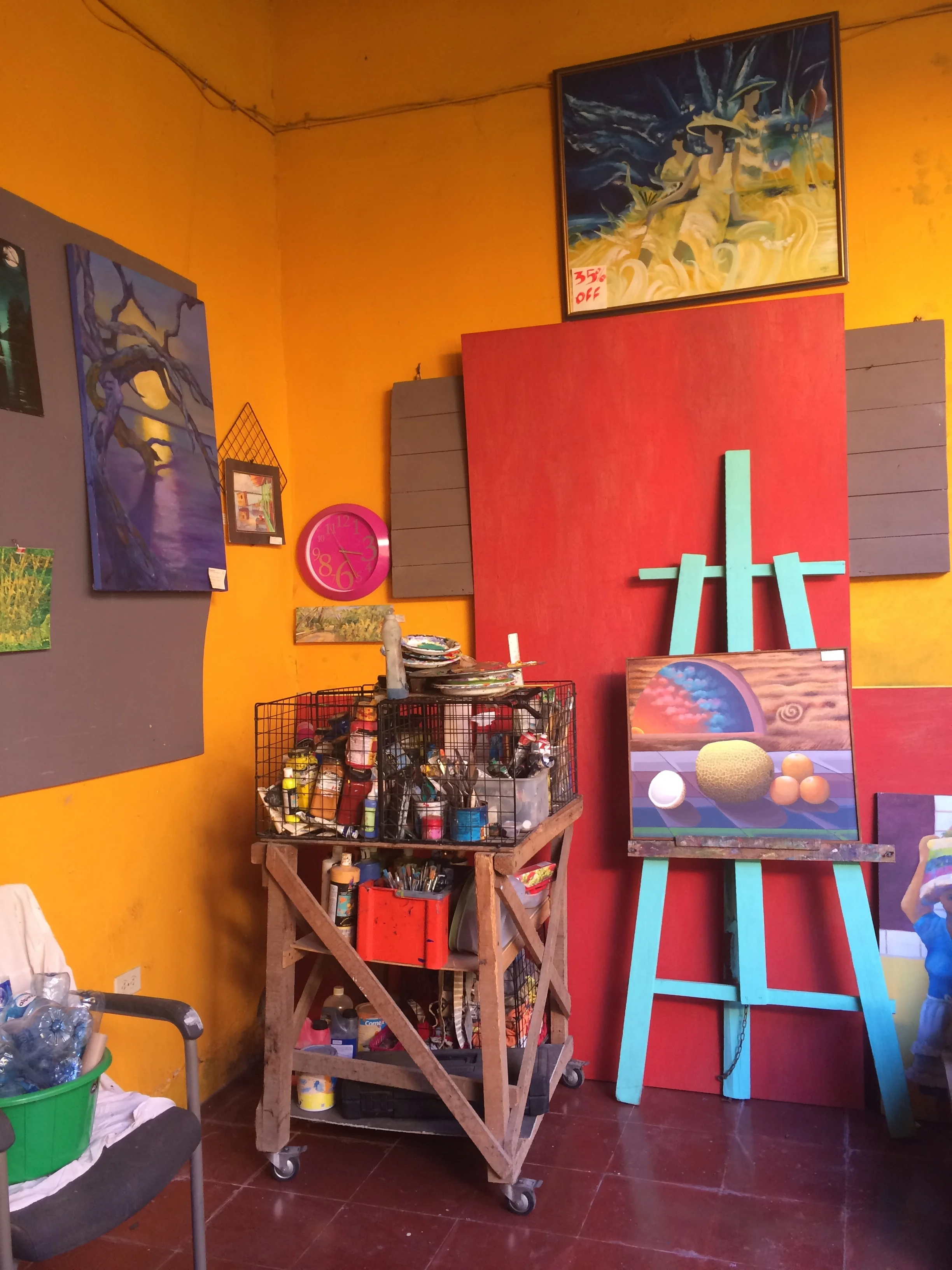On the Zipline
During this trip to Central America, I made the tough and boring decision not to go ziplining. For me, it was one of the more expensive activities, and I had already done it a couple of times before in Mexico and Costa Rica. We took a day tour on Ometepe Island, where our hostel owner drove us around to stop at different sights to see, one of which was a ziplining course because Andrea, my newfound travel companion, had her heart set on soaring through the canopies.
It was hard to resist saddling into the harness once we were at the sign-in booth, but the guides told us we could all hike up to the first platform together to check out the views from the top. Even though we were walking up the steep sides of a volcano, hiking felt so refreshing after a few days of traveling and typical holiday overindulgence. As we climbed higher, I could feel the crisp air invigorating my lungs as my body worked toward a physical goal.
Once we slowed to a stop at the lookout point, my racing heart and the awesome view reminded me that I could enjoy hiking just as much as ziplining. I could find these same sensations while kayaking, jumping off a rope swing at a swimming pool, or simply on a brisk walk through the woods. Our bodies crave movement, and almost any activity can provide an adrenaline rush if your brain is fully attuned to what you're doing. You can even find a sense of awe in the changes of your heartbeat and the rhythm of your breath. Of course, there are some adventure sports that seem unmatched in their sense of excitement, but a lot of the time, our level of attention is what makes the difference.
Namaste Nicaragua
Getting out of Nicaragua turned out to be a very Nicaraguan experience. It took about 40 minutes to check out of my hostel because it was the receptionist's first day, and she had to do a lot of reconciliation between a paper notebook and the computer system. I didn't mind too much because I was recovering from a multi-day stomach situation, so I was just existing in a fog while waiting until the next time I could sit down again. I lugged my backpacks and yoga mat over to a different hostel to catch the airport shuttle, happy to sink into a new seat for a couple hours. Unfortunately, after leaving on time at 9:30am, we had made the journey out of town and then back again to pick up a new rider, so by 10am we were on exactly the same street as where we had started. There was a man from Toronto sucking on a lollipop while yelling at the bus driver to let him off so he could get a taxi instead and a Spanish couple telling everyone to shut up, "¡Dale gas!", and get a move on. It was all quite a sight to see.
Since the only shared and affordable shuttle left at 9:30 and my flight wasn't until 4:15pm, I had a lot of time in the Managua airport to feel sick and poke at a soggy Subway sandwich. Then there was a flight where i had the whole emergency exit row to myself and I used electronic devices the entire time even though they told me not to and didn't tell anyone I was sick even though the safety pamphlet told me to. Later, a talkative taxi driver rolled me through a new Central American city with more reminders of the comforts of home, like how someone had peeled off the "Mc" letters in the golden sign so that it only said "Donald's" which I thought was funny in an ironic way.
Cobblestone streets told me that we were in Antigua, and I was dropped off in a much nicer hostel than any in which I've ever stayed. One of the very friendly desk employees showed me my capsule bed (in three stories of bunks!) and the bathrooms, including a (hot!) shower. Then he took me up to the rooftop terrace where it was dark, but I found out the next day that it looked like this:
There was a lot waiting for me here.
Perusing Playas
Hostel life is all free and easy until you are on the bottom bunk and start to hear the sounds of two humans mating above you on the top bunk. This is perhaps not the level of immersion in nature that you were expecting, but I suppose it's good to know that everyone is having fun and getting along.
I took the short trip up to Playa Maderas for the better beaches and more mellow (read: old person) scene than San Juan del Sur. The beach was indeed beautiful and less crowded, and there were giant sand dollars floating around the waters. The hostel I stayed in was more like a nice hotel (except that generally in nice hotels people aren't getting it on in the same room as you), which provided a quiet escape from the party vibes of San Juan del Sur, but it felt a little isolating for me since it was a separate resort, and I hadn't been in San Juan long enough to be affected by those vibes. After two nights, I was ready to go back down south to the beach town, but I enjoyed the hostel's offering yoga (and letting me teach it for a free meal!) and having a movie theater.
Sun, Sand, San Juan del Sur
I was told to skip right through San Juan del Sur and head to less college-party areas, but whoever told me that must have severely underestimated this girl and her affinity for the vibes of a small beach city town.
I found out where it's at, and it's here. It's been here all along. People are walking around barefoot, riding from beach to beach in the back of pickup trucks, and, yes, occasionally passing out facedown in the street after too much of their famous "Sunday Funday". I was feeling under the weather for the two days here, so I missed out on all of that.
SJdS is like a tiny California with way fewer cars and celebrities. And since the college and college-minded people are getting messed up, there are always good drink specials and cheap tacos. For bonus points, there are also howler monkeys and iguanas. I'm ok with it.
A New Kind of New Year
Once you've spent Christmas by yourself, New Year's Eve is really no sweat. You can easily ignore it altogether, or talk to a lot of happy drunk people, if you're into social activities. It's up to you. I wasn't sure if going to an electronic music party in the middle of an island jungle was a good thing to do by myself on the last night of the year, but it actually was quite a nice thing to do.
New friends braided my hair and painted my face, which I am into. The host showing us to our bunkbeds told us we could use the yoga platform for a late night/early morning cuddle puddle with strangers, which I am not into. Luckily, everyone in the jungle is able to do what they please-- including the pigs, cows, horses, dogs, and chickens wandering all over the streets. New Year's Eve is a good time to examine if you're doing what you're into, or what you're not into, and then prepare for a fresh set of 365 days to adjust accordingly.
This island paradise provided a perfect space for that kind of reflection.
Adioses Agridulces
It's coming down to the end of my stay in Granada. Today was the last morning of teaching at the hotel, and this afternoon I'll be on a ferry to an island of big volcanoes in Lake Nicaragua. Even though the days were slow and hazy, the whole of this month has really flown by. I packed my (somehow heavier) backpacks, and I'll be heading out with a grateful heart.
I never want this page to be somewhere where I only tell you the rosy side of things and leave out the parts that don't fit with that view, so I want you to know that I'm leaving Granada with some mixed reviews, and I feel ready to move on to other parts of the country. I loved being here to work; my first time teaching yoga internationally truly blew me away. The guests were kind, interesting, and into the classes. Eloisa and Danilo were so helpful and accommodating; they made it easy to feel at home around the house and the hotel, right from the beginning. And the hotel-- wow! I can definitely recommend somewhere to stay if you're ever looking to treat yourself well in Central America.
Granada and its surroundings are gorgeous and very easy to get around. I was surprised at the amount of activities there were to do, because, before I got here, I had worried about spending a whole month in a small city where almost everything is in walking distance. Eloisa knew that we traveling yogis are the roaming type, so she usually recommends that teachers only sign on for a month at a time. That made me a little nervous, but I definitely felt that there were enough new things to maintain my adventurous spirit during the time I was here.
The only complaint that I kept coming back to day after day, or really every time that I left the house, was that the catcalling got old pretty fast, and it was hard not to let it spoil things for me. Granada is a safe city, and I'm sure there are plenty of women who will say they felt perfectly fine traveling alone here or that it's all just another part of the culture, but I quickly grew tired of getting whistled, hissed, or blown kisses at whenever I stepped out the door, and that men ages 13-80 would make comments whenever I passed by them. One girl told me she tried to take them as compliments or was able to ignore them. Unfortunately, it made me uncomfortable being on my own, and it kept me from taking day trips to nearby markets or, I felt, from fully experiencing the local culture. After about two weeks, I started spending longer hours in cafes, the touristy ones, with the wifi and organic fruit bowls, where I wouldn't stand out so much. I got a lot of reading done and the smoothies were always delicious, but I normally love walking around as a way to get to know a city, and my discomfort kept me pretty sedentary here.
On the other hand, I wouldn't want that impression to discourage anyone from visiting Granada. The discomfort didn't really start to put me in a sour mood until the second half of my visit, and I don't think a short-term visitor would be as bothered by it since they wouldn't have to hear aggressive remarks at 7am on their walk to work or on a sweaty haul back from the grocery store. I still think Granada is a marvelous place that is not to be missed, and I hope more Americans come down to see it soon because the Canadians have been arriving in droves. I am so thankful for the job here and the graciousness of the people I met, and I'll bet plenty of foreigners visiting the US have felt uncomfortable for some reason or another. And I can tell you where to get any type of refreshing mixed fruit concoction as soon as you step out of the cab here. So, ya know, mixed feelings!
Christmas at Casa Lucia
"Are you sad to be spending Christmas away from home?" Everyone has asked me since I found out I'd be spending December here. And yes, of course I'm a little sad! Of course I would rather be at home hanging out with my family! I love my family! My family is awesome! I miss them!
But you know, getting a job teaching one of your favorite things in a pretty cool place doesn't come around every month, so even when I found out that month was going to be enveloping December 25th, I had to say yes. It's my first time being away from home at this time of year, but it makes me happy to be in a country where the holidays are a pretty big deal. I still get to see lights, Christmas trees, and other decorations in the streets. Eloisa and Danilo have added some sweet little touches around the hotel, too.
I'd always rather be spending Christmas Eve and Day eating pierogi, watching A Christmas Story six times, and catching up with the loved ones I don't get to see very often, but the rest of the month hasn't been so bad. We're working by the pool and playing in the sun-- if it weren't for the ornaments, we might not have known it was winter at all!
Isletas de Granada
It took me a tiny while, but I finally made it to one of the most visited items on the to-do list here... the Isletas de Granada. I didn't know much about this before I showed up, but Granada has 365 tiny islands resting right off its shores in Lake Nicaragua, and you can tour around them by boat or by kayak.
I had wanted to visit the islands since the first day, but everyone told me that the guides won't go out for just one person. Unfortunately, the friends I've made here have either been leaving the next day or long-time retired residents, so I was on my own. I decided to walk down to the office to find out if I could sign up with another group that afternoon. I got there there just in time. There was a kayaking group leaving immediately, so they packed me into the van and we set out on our way.
It was a short drive down to the dock, and then we spent the next 3 hours kayaking all around the islands to see different types of birds, plant life, and howler monkeys! The rest of the day unfolded perfectly. We found ourselves paddling back with the view of sunset over Mombacho Volcano.
I didn't have a preference at first, since I really do not have the hang of kayaking no matter how many times I try, but I was so glad to have been roped into a kayak tour instead of the boat. The water was peaceful and still as we made our way out in between lily pads and flowers. And although the wind made things quite choppy on the way back, the view was enough to keep us moving in our return journey.
La Nica Navidad
Christmas celebrations are already in full swing in Granada! The neighbors have been setting off fireworks all day and night in the street since before I arrived, and there seems to be no end in sight. December is filled with preparations and processions, and most of the celebrated images are not of Jesus or Santa Claus, but of the Virgin Mary, whose statue has been paraded up and down every street in town. Her image is everywhere, and there it will remain until December 24th, That's the day that Christmas happens here. The 25th is just another day.
I'm sure being away from New York for the first time will make me a little homesick, but I'm looking forward to seeing all the holiday fanfare from a different cultural perspective. I only wish I had more room in my suitcase for the Santa piñatas they've been selling in the central square!
City Strolls
Sometimes when you're traveling alone in another country, it's tricky to know where to go and when. You'll hear conflicting reviews from all around. You'll find a recommended attraction and some will tell you never to go anywhere by yourself; you'll surely get robbed and murdered. Others laugh at you and wonder why you would even question going there in the first place; it's perfectly fine!
I've taken baby steps in walking everywhere I can around here. And it's turned out that all the places I've wanted to see have been worthwhile and safe. I've walked to the abandoned Old Hospital and the nearby train station. Since the houses are so colorful and the city is a manageable size, it's a usually a pleasure to stroll around anywhere you can. You might even find goats and horses grazing on a regular old jaunt to the grocery store.
Of course, I am careful and I stick to the well-traveled areas when it gets dark. But it seems that it's easy to explore most of Granada's main attractions on foot (or boat), and the most dangerous part is being in direct sunlight at mid-day. Of course, there are always taxis or horse-drawn carriages that will take you anywhere you don't feel comfortable walking.
La Boca del Infierno
I arrive to meet the group at the tourism office at 4:30pm, and we drive towards the volcano. The gate opens every night at six. Until then, we'll wait in a long line of cars outside the entrance. The convenience store outside our truck sells beer, juice, chips, and one Snickers bar. I sit on the curb to sip a Toña and watch as the sky turns from blue to pink. Eventually the cars begin to roll forward, and our guide delivers a lesson about explorers, craters, and other volcanoes in the area. I'm only half listening. I'll end up remembering that in this part of Nicaragua there is a salamander with zero pigmentation in its skin and a shark that can hold two months worth of salt water inside its body while it heads off to live in fresh water for some time. It strikes me as alarming that Spanish explorers were more interested in searching for gold than in discovering stuff like this. They must not have known about the salamanders.
We arrive at the volcano's museum and our eager guide walks us around, pointing out paintings of animals and telling us where each one is likely to be found. I see a group of live bats fluttering above us and hanging from the ceiling, but the guide ushers us through the man-made replica of a lava tunnel and leads us to more animal paintings instead. He translates their names into English for me, although I don't need him to. He tells me he's studied English since he was 15 when he set his mind to mastering it. Now he's 24 and he can understand anyone and talk about anything because he constantly improves upon his vocabulary and pronunciation. Outside, he shows me a tree of “almendras-- almonds” and tells me that they grow inside of a fruit that encases them, like a “cáscara-- a sheel.”
We make a stop at the museum's mirador. Our guide points out past the lagoon toward the horizon and tells us that just outside of the glowing city of Masaya lies Coyotepe Fortress, which marks the spot of an underground prison left over from the years of the Samoza dictatorship. The prison, a prime location for torturing political prisoners during the late 20th century, is submerged beneath the earth.
When the prison was active, very little light was allowed into the cells and connecting tunnels, ensuring that prisoners wouldn't be able to tell what time of day it was.
“Otra forma de tortura,” our guide explains.
To solicit information about the rebels' efforts, the guards inserted electric rods underneath the fingernails on their victims.
“Otra forma de tortura,” he adds.
And the cells were never cleaned. Often, when a prisoner died, the guards left the body until it decomposed on its own.
“Otra forma de tortura.”
He says it this time with the same tone as the two times before it, as if being left to go on living in the same room as a dead person carries the same weight as not knowing the time or receiving a piercing shock under your fingernails. I can't tell whether it's night or day, and also there is a man who used to be alive lying next to me with his face half eaten by maggots.
My yoga teacher had this lesson he would teach every now and then about the power of the conjunctions we choose in daily speech. When we use “but”, we automatically create a hierarchy or insinuate emotion. We imply that one clause holds a certain sway above the other. It is raining, but I am having a good day. We have already judged the rain. It is clearly something we have had to overcome. Not a gift. Not the bringer of life, but a burden to bear. When we use “and” instead, we remove much of the reaction from the equation. I stepped in a puddle, and I am going to get a sandwich. How do you feel about stepping in the puddle? Did it add a grumpy trudge to the rest of your walk? Or was it the joyous splash of a child? And the sandwich, is that a food common to your diet? Will you enjoy it? With “and”, we have simply delivered the facts.
I can't tell how long I've been in here, and there is a dead body rotting next to me. Actually, using “but” in this case might have recognized a valid blessing, a saving grace. If you have a general idea of about how long it takes a body to decompose under the earth (8 to 12 years), this might prove revelatory in your development of a timeframe. I can't tell whether it's day or night, and they're going to stab at my sensitive under nails with shocking needles, but there's a dead body here next to me. What luck.
We walk solemnly back to the van. The sky above is dark, and the city lights glimmer down below us. We complete our short drive to the edge of the volcanic crater. We step out of the van to see crimson smoke plumes rising over a bright orange glow. We take out our cameras or phones and try to find the right setting and filter to translate these images to our families and friends back home. If only they could see us now. We're all standing in the same line, taking the same photos.
The real stories are below us.
Ring of Fire
Most of the time, the overlook points at Mombacho Volcano provide some of the best views of the city of Granada from high above. On the day I went, everything looked like this:
One of the many perks of working for the hotel is that when guests go on excursions, I can join and pay less than it would normally cost since I become part of a bigger group. Sadly, this meant going to the prettiest one on the rainiest day, but all the lush greenery in the cloud forest was still a sight to see.
On another day, we visited the more active Masaya Volcano, where you can drive up to the top at night and check out the red lava bubbling inside the crater. I've never seen glowing lava before, so that was a unique experience. Plus, there were a lot of bats flying around inside the museum and outside around the volcano, and you know we like those.
Workouts Worldwide
I don't know about this. What do y'all think? I alternate back and forth between telling myself that exercising at a gym is silly and pointless to wondering how on earth I would be alive without free weights and a treadmill. I joined the one here because they have yoga classes, there's a tortoise named Snoopi, and they sell a 10 meal pass for $35. I don't think I would have joined if this were a regular month, but I didn't work out at all in Southeast Asia, and there's been a hefty amount of noodles and rice on these menus.
I usually like to run in the streets to see things and take pictures, but this would have to happen at 5:30am here to take advantage of the cooler weather and make it in time to teach the morning class. And who knows what the catcalling population would have to say about lady parts bouncing around in (gasp) yoga pants and a tank top. Running is not a big part of the culture in Nicaragua.
I tried doing one minute sets of pushups, ab stuff, squats, and leg activities in my room, but I don't really like working out as soon as I roll out of bed in the morning or right before bed, and other times leave too loose a schedule to actually commit to it. Excuses always abound for me and the at-home workout. Plus, using weights usually equals less work for more rewards. So to the gym it is.
There's a chance, too, that it will be a good place to socialize since the other night Danilo's friend introduced me to her daughter by saying, “This is Corinne, the yoga instructor. She has no friends, doesn't know anyone, and has to eat every meal alone.” I thought I was doing okay, but with any luck, my new workout pals will help me surpass her description of me.
Houses & Homes
The colonial-style houses here hold secrets. From the outside, they are as attractive and colorful as a box of crayons, but size-wise they don't look like much. Walking past the exterior, you'd never know what was inside. In our house, for example, you enter the front door and walk into an open air living room, kitchen, and sitting area, all of which surround a green courtyard, filled with plants, blue sky, a fountain, and some cats lazing in the sun. There are four bedrooms, and an indoor/outdoor pool, but you'd never know it from the outside. Other houses on the street hold even more members of the family. You can tell because at night they ditch the shady common areas and hang out on the sidewalks outside their front doors. Family time and ties are essential here.
I'm glad to be staying with the hotel owner, Eloisa, and her boyfriend, Danilo, so I can enjoy a peek into what Nicaraguan life is like (for the financially well-off, at least). I've always found trips where I stayed with a host family to be a little more special than backpacking through hostels, even though each method can be rewarding in its own way.
When I was interviewing for the job, Eloisa kept warning how hot it is here. I can assure you that she's never been to Texas in the summer. It's really only hot hot here at midday. The morning brings a refreshing breeze that blows through the outdoor yoga shala at the hotel and everything chills back out by 4pm. In the meantime, there's plenty of shade and no shortage of places to keep cool.
The shower is cold, shocking, and handheld but it's a nice way to lower your temperature before bedtime. There's no A/C anywhere, so I may have to give up my granola crunching stance against anti-perspirant, but for now, I'll just be slathering myself in essential oils and making sure no one comes too close.
Globetrotting Goals
In case you did not already assume this, being an international yoga instructor at a boutique hotel is actually not very much work. I teach a group class every morning and some days at night, check people in at the front desk sometimes, and make myself available in case someone wants to schedule a private class in the afternoon. Since I enjoy teaching yoga, and would usually be doing it anyway, none of this feels like work at all. And in a small city like Granada where everything is a few blocks away, my schedule leaves a lot of time for relaxing and taking a break from it all.
This is wonderful. The scenery is incredible. The lack of a huge tourist population makes everything very peaceful. On the other hand, for me, there is not a very big “all” from which I am supposed to be taking a break. It would be very easy to spend days here reading entire books, taking naps in hammocks, and lounging around swimming pools. That is nice. Very nice. However, my normal life right now is one big abyss of relaxing solitude and, despite the niceness, I don't want to look back on a whole month remembering that all I did was nap and lounge. So, in true former corporate slave fashion, I have set some loose goals for myself (only three!) for the trip and here they are, en español:
Crear: This has been one of the themes of this whole year for me. I've been pushing to explore creative pursuits instead of putting them off and wishing upon a star that I get around to them someday. Someday is here, and, fortunately, for such a little city, Granada has a robust art scene with a surprising number of art galleries. Apart from that, the houses and buildings are so colorful that one doesn't have to look far for inspiration. I packed some paints and brushes, and this Central American world is my canvas.
Hablar: One helpful skill that I've acquired in this lifetime is the ability to speak Spanish. If we're talking about where I'm from, or my family, or ordering at a restaurant, local people are usually surprised that I can speak it so well. At this point, they should be more surprised at the hesitation I feel about speaking it candidly and the number of stumbles and roadblocks that come up in more meaningful conversations. I have seventeen years of experience and a Master's degree for goodness' sake. On this trip, I'm trying to delve a little further than my heavily chartered territory, and make a focused effort not to shy away from longer conversations.
Sentar: The third goal is really a tricky anti-goal. Besides the constant drive toward self-improvement that is probably a shadow from my next decade looming on the horizon, I would like to be a part of the slower-paced life that the people here are living. They're sitting outside on their patios, spending time with family, and strolling through the streets to meet up after dark. After four days of this, I can already feel myself wanting to join a gym, schedule excursions, go for a jog, take classes, try every cafe, visit every art gallery, etc. etc. I'm trying to remember that all this doing isn't always the most rewarding thing, and that the most memorable outings usually are not on the checklist.
Tierra Soñada
Hey ladies, if you are looking for a confidence booster where you walk out of the house and all the men in a city remark upon your beauty and profess their love to you, look no further than here in Granada, Nicaragua. If you are not looking for that, you might find it off-putting, but, chances are, you will probably like this place anyway.
I'm surprised they've even noticed me; there's plenty of other beautiful stuff around here.
So far, nearly everything has wildly exceeding my expectations. I finally felt like I made it when there was a private driver holding a sign with my name on it as soon as I stepped out of the airport. He pressed himself right against the glass door, which was good because coming out of the airport is when I am looking most gringa and like I don't know where the F I'm going, and when I am feeling most afraid of being thrown in the back of a truck and sex-trafficked. I don't know the first thing about actual sex trafficking, but I can only assume it is happening all the time to blue-eyed girls in foreign nations, based purely on the number of strangers who approach me to tell me to be careful and not to be too trusting of strangers.
The hotel owner (and my boss) is most helpful and very sweet. There's a house and a hotel, two pools, good food, good yoga, and cheap living. We're only on day two, but I think I'm going to enjoy myself here.
The System
Ten minutes past security and I've already lost the tag for my checked luggage. Where has it gone? Probably fallen off onto the TSA conveyor belt. This is fine. I lose things. Only if they are not part of The System. My system. Where all the items that come on these trips have a place. I'm familiar with the place and know exactly where to go to summon each item at need. But this time I'm carrying a new backpack, and The System and placements have shifted slightly. I am expecting some losses, especially after spending a rushed morning realizing I needed to visit the ATM before dropping my car off in its spot, the extra spot at Andy's house.
I took out $200 and wondered if I should spread it out around my pockets in case of a robbery in the Third World. I ultimately decided not to, since, somewhere along the way, I came to reason that anything below $200 is Not That Big of a Deal, whereas spending or losing anywhere above $200 would qualify as a Very Big Deal. I am unsure where I gathered this logic since you would think that spending or losing any amount of money would be at least a Pretty Big Deal to someone without a steady job or a plan. But, nevertheless, it's all there, in my wallet, inside my backpack, and we are headed down to the Third World.
Maybe the Second World is really the plane that takes us from our world to theirs. It's not so often that it occurs the other way around. We go there to take and see, or to stay and give and feel like we are doing something to assuage the guilt of our having laid waste to their land and their economy. I used to be one of ones who desired to help, to make a difference, to be a face of America (the one and only) abroad. And now, what has changed? I no longer want the face that says, “Look at me. I'm OK! Everything that I represent must not be so bad! I am kind. I've brought gifts. And my language!-- you can only imagine the doors that would open if I were to teach it to you! Sure, I'm a little different than most of my people. I'm young! I've got time to be here. And you can bet that my parents are footing the bill. They're at work being normal so I can be here. A volunteer. One of the special ones. Here to show you what it's like to have what we have, how much better it would be to live the way we live.”
And then I might realize that, beyond the supplies, this may not be helping you at all. I've brought my kindness here, but you already knew about that. We could talk about family planning, but it seems the bonds in yours are stronger than mine at home. I can show you about business, but it's our business. It'd be ignorant to assume you don't have your own. I know a little bit about health and fitness. I can bring you medicines so someday you'll be well and strong. And for what? To live a long life and improve your society until it becomes an efficient and stable part of The System. Our system, where all the parts have a place, and we are familiar with the place and know exactly where to go to summon each item at need.
This time around, I think I'll just worry about what's in my backpack.






